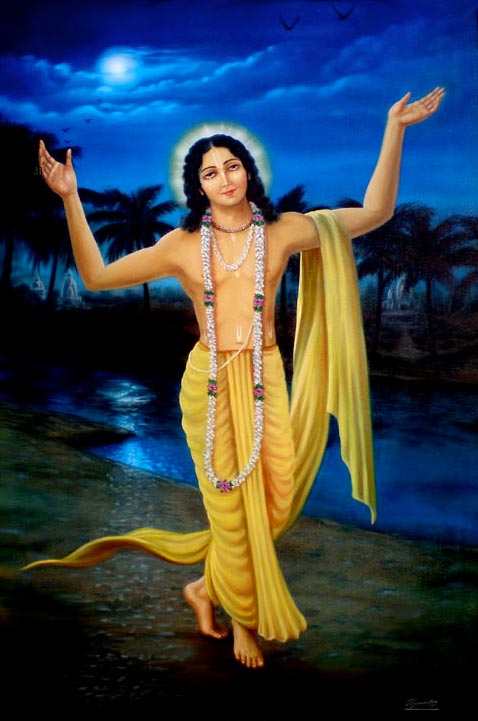Lord Caitanya and the Renaissance of Devotion (Part 2)
By Ravindra Svarupa Dasa | Apr 11, 2009

Krishna’s appearance as Lord Caitanya is really Krishna’s own tribute and testament to the overwhelming attractiveness of pure devotional service and, especially, of His pure devotee. Moreover, when Krishna assumes the features of His own greatest devotee, He has, in fact, a particular devotee in mind: His highest and most intimate devotee. Srimati Radharani.
You may have seen paintings that depict Radha and Krishna together; Lord Krishna appears as a beautiful young man with a dark-blue complexion that glows like a newly formed rain cloud illuminated within by lightning. Srimati Radharani is an equally beautiful young girl; Her complexion is lustrous like molten gold. Krishna plays on His flute, and Radharani, Her hand resting lightly on Krishna’s shoulder, listens in enchantment. It is clear from Their posture and from the way They glance at each other that They are deeply in love.
Westerners often misunderstand Radha, and Krishna. An earlier, puritanical generation was appalled at the notion that God should have a consort and enter into a conjugal relationship. Nowadays, one encounters people from a younger generation who are very much “into” sex and are delighted to think that God is too. Both groups radically misunderstand Radha and Krishna, because both share in a common error: that the relationship between Radharani and Krishna is like a mundane sexual relationship.
Male and female and the attraction between them are found in this world only because sexual polarity and attraction exist originally in God, in Radha-Krishna. As above, so here below. But there is a difference also. Worldly sexual relationships are merely perverted reflections of the original and transcendental conjugal relationship between Radha and Krishna, which is pure and spiritual and devoid of any tinge of lust. As long as Our materially besmirched minds are conditioned by worldly desire, we are unable to conceive of the immaculate love between Radha and Krishna. We project our own unwholesome relationships and unholy loves onto God. This is surely a mistake. A person can understand the conjugal love of Radha and Krishna as it is only if he himself becomes free from lust. Lord Caitanya was able to make an unprecedented disclosure of the confidential relationship between Radharani and Krishna because He also taught the chanting of Hare Krishna, which destroys lust and other material impurities with unrivaled efficacy.
We can understand the position of Srimati Radharani by means of the ideas of “potency” (shakti) and the “potent” (shaktiman), that is, of power or energy, on the one hand, and of the possessor of the power, the energetic source, on the other. To use an illustration, fire is the potent, and heat and light are the fire’s potency. But the supremely potent, the ultimate source of all energies, is Krishna; everything else, material or spiritual, is His potency, emanating from Him as heat and light emanate from a fire. (Heat and light are potency in relation to the potent fire; fire, potency in relation to the potent sun; the sun, potency in relation to Krishna, the supremely potent.) The entire content of what is can be exhaustively described as Krishna and His energies.
Three of Krishna’s multitudinous potencies are prominent. One of them manifests the whole material world; another, the innumerable spiritual souls. The third—called the internal potency—manifests the transcendental kingdom of God. This internal potency has three further subdivisions. By one of these transcendental potencies, Krishna maintains His existence and that of the eternal kingdom of God; by another, He knows Himself and causes others to know Him. And by the third internal potency He enjoys transcendental bliss and causes His devotees to feel bliss.
This internal potency of bliss, called hladini-shakti, is Srimati Radharani. As the embodiment of Krishna’s transcendental pleasure-giving potency, Srimati Radharani is Krishna’s most perfect devotee; She lives only for satisfying Him with Her pure devotional love. All devotional service falls under the auspices of Srimati Radharani, and only by Her mercy and care are the devotees able to please Her beloved Krishna. She is the ideal devotee, the exemplar of unconditioned love.
Krishna and Radha are simultaneously one and yet different, just as a fire and its light are one and yet different at the same time. Thus, although Radharani and Krishna are one in Their identity, They have separated Themselves eternally. Radha and Krishna together exemplify the simultaneous oneness and difference of the Supreme Personality of Godhead and His energy, constituting the whole of the Absolute Truth. Thus they illustrate the most profound metaphysical principle.
Radharani and Krishna show that the ultimate nature of God contains internal varieties, and Their endless reciprocation of love is the basis of an internal transcendental dynamic by which Krishna is eternally increasing in beauty and bliss. Although Radha has no desire for her own enjoyment, when She sees Krishna, Her joy increases without bound. Because Her joy increases, Her sweetness and beauty also increase. When Krishna sees Radha becoming more and more beautiful, His joy also becomes greater, making His beauty and His sweetness grow. When Radha sees that She has pleased Krishna, She becomes overjoyed, and as Her joy multiplies, She becomes even more beautiful and sweet. This again increases Krishna’s own joy, beauty, and sweetness. . . . And so the reciprocation goes on and on, without limit or end.
The name Krishna means “all-attractive,” and knowing the reciprocation of ever-increasing love between Radha and Krishna allows us to appreciate how attractive God is—much more attractive than anything in this world. When God is misconceived as static and without variegatedness, it makes the material world seem more interesting and alluring by comparison. Just this sort of static conception was borrowed by Christian philosophers from Aristotle and enshrined in medieval theology; and this is one reason why the Renaissance turned to the material world for a sense of promise, adventure, and expanding possibilities. For God was philosophically understood as actus purus, which meant that He was everything that He could ever be; He was entirely static, a kind of crystalized, frozen perfection.
It was thought that if God possesses the fullness of infinite perfection, then the divine perfection would be at an absolute maximum and could not increase. But Krishnadasa Kaviraja says that although God is at the fullness of perfection, He still does increase. The apparent paradox may be easier to accept if you consider a similar “paradox” discovered by modern mathematicians in their investigation of the properties of infinite sets. Let us consider, for example, a hotel with infinite rooms, all of which are occupied. Although the hotel is full, you can always add more guests—in fact, an infinite number of guests. Let us imagine that the desk clerk wants to check in a new guest. He blows a whistle, and all the doors open. The occupant of room 1 moves to room 2, of 2 to room 3, . . . and so on, ad infinitum. The new guest enters the now-empty room 1. Similarly, even though an infinite number of guests check out of the hotel, it will retain full occupancy. The Isopanisad makes a similar point about the Supreme Personality of Godhead: He is so complete that even though countless energies emanate from Him, He remains complete and wholly undiminished. And although Krishna is full and complete, yet, through His loving reciprocation with Radha, He eternally increases without limit.
Lord Caitanya also embodies another phase in the transcendental psychology of the loving reciprocation between Radha and Krishna. We have already seen how Krishna is ceaselessly fascinated and attracted by Radha. He finds Her love for Him equally amazing. Its selfless purity and its intensity fill Him with wonder. KrishnadÄsa KavirÄja tells us that Krishna thinks to Himself, “Whatever pleasure I get from tasting My love for Srimati Radharani, She tastes ten million times more than Me by Her love.” Krishna is the supreme enjoyer, but He realizes that Srimati Radharani, by Her love for Him, enjoys even more bliss than He does. Thus Krishna becomes eager to experience for Himself the flavor of Srimati Radharani’s love for Him.
Krishna’s beauty and sweetness are so limitless that they attract the whole universe. Krishnadasa Kaviraja says: “The beauty of Krishna has one natural strength: it thrills the hearts of all men and women, beginning with Lord Krishna Himself. All minds are attracted by hearing his sweet voice and flute, or by seeing His beauty. Even Lord Krishna Himself makes efforts to taste that sweetness.” But the one who relishes Krishna’s beauty and sweetness the most is Srimati Radharani. Her immaculate love is like a flawless mirror, and in that mirror Krishna’s own beauty and sweetness shine with ever greater brightness. Thus Krishna desires to experience His own attractiveness in the way that Srimati Radharani does.
For these reasons, then, Krishna desires to take the position of Srimati Radharani. That desire is eternally fulfilled in the person of Lord Caitanya. In His form as Lord Caitanya, Krishna assumes the golden complexion and the devotional feelings of Radha, and tastes for Himself the unlimited bliss of devotional service.
Krishnadasa Kaviraja sets down two verses in which he summarizes the nature of Lord Caitanya: “The loving affairs of Sri Radha and Krishna are transcendental manifestations of the Lord’s internal pleasure-giving potency. Although Radha and Krishna are one in Their identity, They separated Themselves eternally. Now these two transcendental identities have again united in the form of Sri Krishna Caitanya. I bow down to Him, who has manifested Himself with the sentiment and complexion of Srimati Radharani although He is Krishna Himself. Desiring to understand the glory of Radharani’s love, the wonderful qualities in Him that She alone relishes through Her love, and the happiness She feels when She realizes the sweetness of His love, the Supreme Lord Hari, richly endowed with Her emotions, appeared from the womb of Srimati Sacidevi, as the moon appeared from the ocean.”
The three transcendental personalities of Radha, Krishna, and Caitanya together manifest the eternal dialectics of divine love, the timeless dynamics of the ever-expanding ocean of transcendental bliss. Lord Caitanya descended to flood the world with that ocean of love by distributing to everyone the chanting of the names of God. Simply by chanting Hare Krishna, anyone can enter into that limitless ocean of the nectar of devotion.
Lord Caitanya inaugurated a bhakti renaissance and turned people’s vision to God at the same time that the Renaissance in Europe turned people’s vision to man and the world. Men like da Vinci, fascinated by the marvelous and cunning complexities of material nature, began to delve into her secrets with an insatiable curiosity and were rewarded with discovery. At the same time, as if in counterbalance, Lord Caitanya, through the renaissance of bhakti, gave to the world an unprecedented view into the inner dynamics of infinite love in the all-attractive Supreme Personality of Godhead. Just as men of the Renaissance tried to open up the world and unlock the secrets of nature, Lord Caitanya and His associates opened up the kingdom of God and unlocked the secrets of love of God.
To the people of the Renaissance, the world and man seemed imbued with limitless possibility and promise. Western civilization to the present day has been following up on that vision, and it becomes more and more apparent that the world and man have not lived up to their promise. The Renaissance shift of vision from God to man and matter has cut people off from any transcendent source of meaning and value, and the resultant relativism and nihilism—the ripened fruit of the Renaissance—have released demonic energies that have devastated the earth in our time. And there is more to come.
Therefore, Lord Caitanya’s appearance was most timely. The civilization born in Europe during the Renaissance has grown to straddle the earth. But there has been a most fortunate counterflux, as the sankirtana movement of Lord Caitanya has also spread over the globe, in fulfillment of Lord Caitanya’s own prophecy. By showing how Krishna is supremely loving and all-attractive, and by making Krishna easily accessible through the chanting of His names, Lord Caitanya has made it possible for us to shift our vision back to God once more. This is necessary. Man and the world cannot answer to the demand we have placed upon them. Only Krishna and His transcendental kingdom, where He eternally revels in pastimes of love, can do that. This alone is the realm that is rich with infinite promise, beckoning to us with limitless possibilities.












